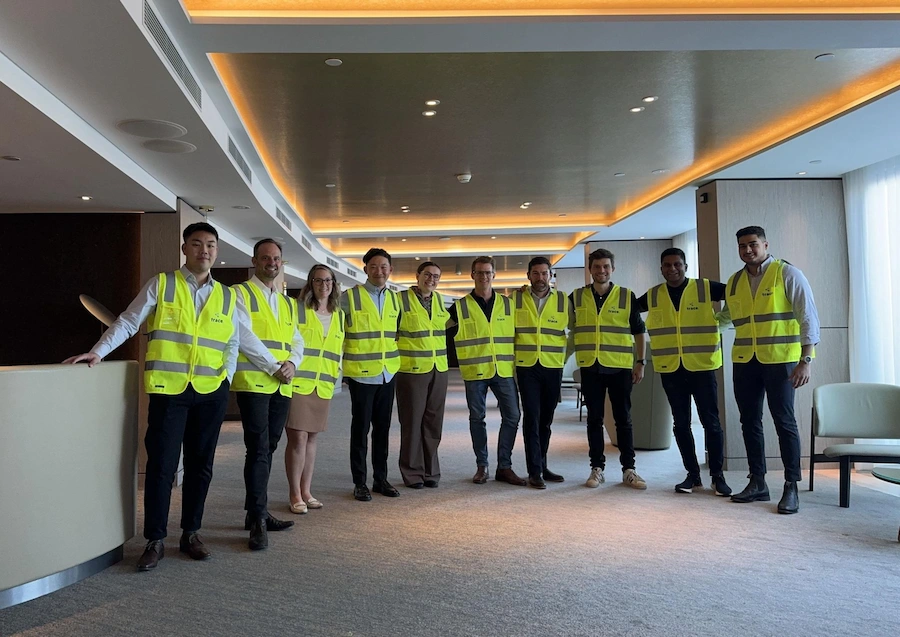Ready to turn insight into action?
We help organisations transform ideas into measurable results with strategies that work in the real world. Let’s talk about how we can solve your most complex supply chain challenges.

In the face of escalating environmental concerns and an increasing push towards sustainable practices, Australian businesses are under mounting pressure to integrate sustainability into their operations. Yet, not all sustainability measures need to be overt or headline-grabbing. By injecting operational excellence into their business practices, Australian supply chains can subtly but significantly impact sustainability. This approach allows companies to enhance their environmental footprint while also achieving cost reductions and operational efficiencies.
This article explores how Australian supply chains can influence sustainability through operational excellence, the principles and strategies involved, and real-world examples demonstrating the tangible benefits of this approach.
Understanding Operational Excellence
Operational excellence is the execution of business strategies more consistently and reliably than the competition, with lower operational risk, lower operating costs, and increased revenues relative to competitors. It's about fostering a culture of continuous improvement and efficiency across all areas of an organisation. When applied to supply chains, operational excellence involves optimising processes to minimise waste, reduce resource consumption, and enhance productivity.
Principles of Operational Excellence
- Continuous Improvement (Kaizen): A core principle of operational excellence is the commitment to continuous improvement. This involves regularly reviewing and refining processes to eliminate inefficiencies and enhance performance.
- Lean Thinking: Lean principles focus on creating more value for customers with fewer resources. This includes identifying and eliminating waste, whether in terms of materials, time, or effort.
- Six Sigma: Six Sigma is a set of techniques and tools for process improvement, aiming to reduce variability and defects. It helps ensure that processes are as efficient and effective as possible.
- Total Quality Management (TQM): TQM is a management approach centered on quality, based on the participation of all members of an organisation in improving processes, products, services, and the culture in which they work.
- Sustainable Practices: Integrating sustainability into operational excellence means considering the environmental impact of every decision and striving to reduce carbon footprints and resource consumption.
The Role of Australian Supply Chains in Sustainability
Australia's unique geographic and economic landscape presents both challenges and opportunities for sustainable supply chain management. The vast distances between cities and regional areas, coupled with a strong reliance on both domestic and international trade, mean that Australian supply chains are complex and resource-intensive. However, by embedding operational excellence into their supply chains, Australian businesses can make significant strides towards sustainability.
Reducing Carbon Footprint
Transportation is one of the most significant contributors to carbon emissions within supply chains. By optimising logistics and transportation routes, companies can reduce fuel consumption and emissions. For example, route planning software can help determine the most efficient delivery paths, reducing the distance traveled and fuel used.
Additionally, investing in greener transportation options, such as electric vehicles or alternative fuels, can further reduce the carbon footprint. Companies like Australia Post are leading the way by incorporating electric delivery vehicles into their fleets, demonstrating the potential for significant environmental benefits.
Minimising Waste
Waste reduction is another critical area where operational excellence can drive sustainability. In supply chain management, waste can take many forms, including excess inventory, packaging materials, and inefficiencies in production processes. By adopting lean principles, companies can identify and eliminate these waste sources.
For example, implementing just-in-time (JIT) inventory systems can reduce excess stock, minimising waste and storage costs. Likewise, optimising packaging materials to use less plastic or incorporate recyclable materials can significantly reduce environmental impact.
Enhancing Resource Efficiency
Operational excellence also involves making the best use of available resources. This includes optimising energy usage in warehouses and production facilities, utilising water more efficiently, and ensuring that raw materials are used effectively.
Energy-efficient practices, such as installing LED lighting, implementing smart energy management systems, and using renewable energy sources, can significantly reduce a company's environmental footprint. Similarly, water-saving technologies and practices can minimise water consumption in water-intensive industries, such as agriculture and manufacturing.
Promoting a Circular Economy
A circular economy aims to keep products, equipment, and infrastructure in use for longer, thus improving the productivity of these resources. Supply chains play a crucial role in promoting circular economy practices, such as recycling, remanufacturing, and refurbishing.
For instance, companies can design products with end-of-life disposal in mind, making them easier to disassemble and recycle. They can also establish reverse logistics systems to collect used products and materials for refurbishment or recycling. By doing so, businesses not only reduce waste but also create new revenue streams from recycled or refurbished products.
Real-World Examples of Sustainable Australian Supply Chains
Woolworths Group
Woolworths Group, one of Australia's largest retailers, has made significant strides in integrating sustainability into its supply chain operations. The company has committed to a range of sustainability initiatives, including reducing carbon emissions, minimising waste, and promoting responsible sourcing.
Reducing Carbon Emissions: Woolworths has set ambitious targets to reduce its carbon footprint, including achieving net-zero emissions by 2050. The company has invested in renewable energy projects, such as installing solar panels on store rooftops, and is transitioning its fleet to electric vehicles.
Minimising Waste: Woolworths has implemented numerous waste reduction initiatives, such as its partnership with TerraCycle to offer recycling solutions for hard-to-recycle items and its commitment to phasing out single-use plastics. The company also donates surplus food to food rescue organisations, diverting it from landfill and helping to address food insecurity.
Promoting Responsible Sourcing: Woolworths is committed to sourcing products sustainably and ethically. This includes working with suppliers to ensure sustainable farming practices, such as reducing water usage and promoting biodiversity, and ensuring that products are sourced in a way that respects human rights and fair labour practices.
BHP
BHP, one of the world's largest mining companies, is another example of an Australian company leading the way in sustainable supply chain management. BHP has integrated sustainability into its business practices, focusing on reducing its environmental impact and promoting responsible resource management.
Reducing Carbon Emissions: BHP has committed to reducing its operational greenhouse gas emissions and achieving net-zero emissions by 2050. The company is investing in low-emission technologies, such as carbon capture and storage, and increasing its use of renewable energy.
Enhancing Resource Efficiency: BHP is focused on improving the efficiency of its resource use, including water and energy. The company has implemented water-saving technologies at its mining sites and is working to improve energy efficiency through initiatives such as optimising equipment usage and implementing energy management systems.
Promoting a Circular Economy: BHP is also exploring opportunities to promote a circular economy within its operations. This includes recycling and reusing materials, such as scrap metal and used equipment, and working with suppliers to develop more sustainable products and packaging.
Lion
Lion, a leading beverage and food company in Australia, has made significant progress in embedding sustainability into its supply chain. The company is committed to reducing its environmental impact through initiatives focused on carbon reduction, waste minimisation, and responsible sourcing.
Reducing Carbon Emissions: Lion has set a goal to achieve net-zero carbon emissions by 2050 and is working towards reducing its operational emissions. The company is investing in renewable energy, such as solar power, and implementing energy-efficient practices in its production facilities.
Minimising Waste: Lion is committed to minimising waste across its operations. The company has introduced initiatives to reduce packaging waste, such as lightweighting packaging materials and increasing the use of recycled content. Lion also works with partners to recycle and reuse waste materials, such as using spent grain from brewing as animal feed.
Responsible Sourcing: Lion is focused on sourcing ingredients and materials sustainably and ethically. This includes working with suppliers to ensure sustainable farming practices and promoting the use of sustainable packaging materials.
Strategies for Injecting Operational Excellence into Business Practices
Embrace Technology and Innovation
Technology plays a critical role in enabling operational excellence and sustainability. By leveraging advanced technologies, such as the Internet of Things (IoT), artificial intelligence (AI), and blockchain, businesses can enhance visibility, traceability, and efficiency across their supply chains.
IoT and AI: IoT devices can collect real-time data from various points in the supply chain, such as production equipment, warehouses, and transportation fleets. This data can be analysed using AI to identify inefficiencies, predict maintenance needs, and optimise operations. For example, predictive maintenance can reduce equipment downtime and energy consumption, while AI-powered demand forecasting can improve inventory management and reduce waste.
Blockchain: Blockchain technology can enhance traceability and transparency in supply chains, ensuring that products are sourced and produced sustainably. By providing a secure and immutable record of transactions, blockchain can help verify the sustainability claims of suppliers and promote responsible sourcing practices.
Foster a Culture of Sustainability
Creating a culture of sustainability within an organisation is essential for achieving long-term success in operational excellence and environmental impact. This involves engaging employees, suppliers, and other stakeholders in sustainability initiatives and fostering a sense of shared responsibility.
Employee Engagement: Encouraging employees to participate in sustainability initiatives can drive meaningful change. This can be achieved through training programs, sustainability challenges, and recognition programs that reward employees for their contributions to sustainability goals.
Supplier Collaboration: Collaborating with suppliers is crucial for promoting sustainable practices across the supply chain. Businesses can work with suppliers to set sustainability standards, share best practices, and develop joint initiatives to reduce environmental impact.
Implement Sustainable Procurement Practices
Sustainable procurement involves considering environmental and social factors in purchasing decisions. By adopting sustainable procurement practices, businesses can influence the sustainability of their supply chains and promote responsible sourcing.
Supplier Assessment: Conducting assessments of suppliers' sustainability practices can help identify those that align with the company's sustainability goals. This can include evaluating suppliers' environmental impact, labour practices, and compliance with sustainability standards.
Green Purchasing: Prioritising the purchase of environmentally friendly products and materials can reduce the environmental footprint of supply chains. This can include sourcing products made from recycled or sustainable materials, choosing energy-efficient equipment, and selecting suppliers with strong sustainability credentials.
Measure and Report Sustainability Performance
Measuring and reporting sustainability performance is essential for tracking progress, identifying areas for improvement, and demonstrating accountability to stakeholders. Businesses can use key performance indicators (KPIs) and sustainability reporting frameworks to assess their environmental impact and communicate their achievements.
KPIs: Developing KPIs related to sustainability, such as carbon emissions, waste reduction, and resource efficiency, can help businesses monitor their performance and set targets for improvement. Regularly reviewing and analysing these metrics can inform decision-making and drive continuous improvement.
Sustainability Reporting: Transparent reporting of sustainability performance can build trust with stakeholders and showcase the company's commitment to sustainability. Businesses can use established reporting frameworks, such as the Global Reporting Initiative (GRI) or the Carbon Disclosure Project (CDP), to communicate their sustainability efforts and achievements.
Australian supply chains have a significant role to play in promoting sustainability by stealth through operational excellence. By optimising processes, reducing waste, and enhancing resource efficiency, businesses can achieve substantial environmental benefits while also realising cost reductions and operational efficiencies.
Through real-world examples, such as Woolworths, BHP, and Lion, we see how Australian companies are successfully integrating sustainability into their supply chain operations. By embracing technology and innovation, fostering a culture of sustainability, implementing sustainable procurement practices, and measuring and reporting sustainability performance, businesses can drive meaningful change and contribute to a more sustainable future.
Incorporating operational excellence into business practices is not just about achieving short-term gains; it's about creating a resilient and sustainable supply chain that can adapt to future challenges and opportunities. As Australian businesses continue to navigate the complexities of the modern market, the principles of operational excellence will be crucial in driving both economic and environmental success.
Ready to turn insight into action?
We help organisations transform ideas into measurable results with strategies that work in the real world. Let’s talk about how we can solve your most complex supply chain challenges.









